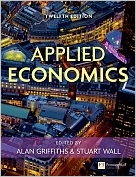Applied Economics equips you with the skills and knowledge to apply
economic analysis to the current economic problems happening in the world today.
Highly praised for its clear presentation, broad coverage of topics, and
unique blend of theory and application, Applied Economics brings the subject to life,
helping you to understand the relevance of economics in the ‘real world’
Table of Contents
Guided tour Preface Acknowledgements
1 Changes in the economic structure
Structure defined
Structural change in the UK
Causes of structural change
Consequences of structural change
Part I: Theory of the firm
2. Financial reports as a source of corporate information
Financial reports and the assessment of company performance
External sources of financial information
3 Firm objectives and firm behaviour
Firm objectives
Firm behaviour
4 Entrepreneurship and small/medium-sized enterprises (SMEs)
Entrepreneurship and business start-ups
Definition of the small firm
The importance of the small firm
The neglect of small firms
The renewed interest in small firms
Measures to help small firms
European Union policy for small firms
5 Mergers and acquisitions in the growth of the firm
Definitions
Types of merger
Economic theory and merger activity
Mergers and the public interest
Merger booms
The control of mergers and acquisitions
Corporate restructuring
6 Oligopoly
The definition and measurement of oligopoly
Oligopoly in theory and practice
7 The multinational corporation
What is a multinational corporation?
How important are the multinationals?
Multinationals and the UK economy
Why do companies become multinational?
The impact of multinationals on the UK economy
8 Privatization and deregulation
Nature and importance
Reasons for nationalization
Privatization
Regulation and deregulation
9 Beyond markets: critical approaches to microeconomics
Classical and neoclassical perspectives on markets
Markets, prices and economic efficiency
Role of the state in neoclassical economics
Institutionalist perspectives on markets
Part II: Environmental, regional and social economics
10 The economics of the environment
The role of the environment
Sustainable economic welfare
Valuing the environment
Market-based and non-market-based incentives
Global warming
11 Transport
The characteristics of transport
The demand for transport
Road transport congestion
Government transport policy
Airline operations and the growth of low-cost carriers
12 Health economics
Health economics, health and health care
Health inequalitites
The organization of the NHS in England
Welfare economics – Pareto
13 Distribution of income and wealth
Distribution and justice
Issues in distribution
Income distribution between people
Income distribution between factors of production
The earnings distribution
The distribution of wealth
Poverty
14 Trade unions, wages and collective bargaining
Types of trade union
Trade union changeThe employers
The government
The structure of collective bargaining
Wage determination and collective bargaining
The effects of collective bargaining
15 Corporate social and ethical responsibility
Corporate social responsibility (CSR): definitions and themes
CSR: a growth phenomenon
Corporate responsibility
CSR perspectives and ethical frameworks
Corporate governance
Part III: Macroeconomics
16 Consumption and saving
Consumption
The Keynesian consumption function
Post-Keynesian theories of the consumption function
The savings ratio
17 Investment
The nature of investment
Gross Fixed Capital Formation (GFCF)
The importance of investment
18 Public expenditure
Trends in UK public spending
Total Managed Expenditure (TME)
Planning, monitoring and control
The size of public expenditure
Explanations of the growth in public expenditure
International comparisons
Should public expenditure be restricted?
19 Taxation
The taxes that are collected: some taxation concepts
The pattern of UK taxation
Does the level of taxation matter?
Direct versus indirect taxes
Tax and social security reform
20 Money and monetary policy
The nature of money
Functions of money
The importance of money
Issues in counting the money stock
The money supply process
The rules versus discretion debate
Monetary policy targets
Central bank credibility
Techniques of monetary policy
UK monetary policy since the 1950s
The making of monetary policy in the UK
Recent developments in UK monetary policy
21 Financial institutions and markets
The role of the financial system
The role of financial intermediaries
UK financial intermediaries
The Bank of England
UK financial markets
The Bank of England and the sterling wholesale money markets
The changing UK banking market
An overview of bank operations and the UK banking collapse
22 Inflation
The definition and measurement of inflation
Low inflation as a policy objective
The effects of inflation on economic growth
Economic theory and inflation
UK inflationary experience: 1970–92
Inflation targets and central bank independence 1992—
23 Unemployment
Unemployment in the UK
International comparisons
Unemployment and economic theory
A framework for thinking about unemployment
Unemployment in the OECD
Unemployment persistence and hysteresis
What can be done to reduce unemployment?
The great recession
Part IV: International economics
24 Globalization
Characteristics of ‘globalization’
Indicators of globalization
Globalization and corporate strategy
Dimensions of globalization
Anti-globalization movements
The US and globalization
25 Exchange rates and trade performance
The foreign exchange market
Exchange rate definitions
Exchange rate determination
Currency ‘warfare’
Economic policy and the exchange rate
The gold standard system
The IMF system
The floating exchange rate system
26 Free trade, regional trading blocs and protectionism
Free trade
Trade and the world economy
Protectionism
27 The European Union
Historical background
Finance and the EU budget
Policy areas
Monetary union
28 The BRIC economies: Brazil, Russia, India and China
Rise of BRIC economies
China
India
Brazil
Russia
29 Growth and development
Theories of economic growth
Productivity and growth
Sustainable development
GNP data, developed and developing countries
Major features of less developed countries (LDCs)
International Development Targets (IDTs)
Urbanization and developing economies
Aid, trade and development
Debt and development
30 Managing the global economy: post ‘credit crunch’
The objectives of policy
The instruments of policy
Problems in managing the economy
The theory of economic policy
Global economic management: post ‘credit crunch’
Sovereign wealth funds (SWFs) and sovereign debt
A guide to sources
Statistical sources
Information sources
Other applied materials
Electronic media
Internet sources
Notes on contributors
Index
728 pages, Paperback


